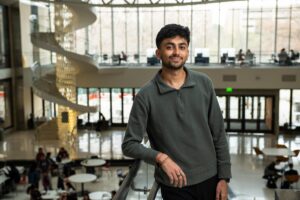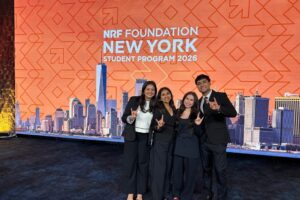
Congratulations to the Class of 2015! In honor of Commencement, which, after all, marks a beginning and not an end, here are 12 stories of how students from this class spent their time at UT and what they’re doing next. Hook ’em.
Photos by Marsha Miller
Videos by Kris Maxwell
Irnela Bajrovic | Biochemistry
“Ask yourself the big questions: What do you care about? What drives you?”
Irnela Bajrovic is philosophical about life choices. The one-time Bosnian refugee grew up knowing that she wanted to help people, to give back to the community, just as she was once helped by hers. Her next step was to figure out the best way to do this.
She started with the Freshman Research Initiative, which opened her appetite for research. Then she joined Maria Croyle’s lab, working on developing vaccines for infectious diseases like ebola that don’t have to be refrigerated, an impracticality in the third world. An internship with the Intellectual Entrepreneurship program and a Kuhn Scholarship enabled Irnela to attend a professional pharmaceutics conference, an experience that cemented her interest in pursuing scientific research as a career.
“I saw people in academia and industry with their Ph.D.s and could really see options that all seem amazing,” she says. “It was an eye-opener and the fuel I needed to aim for grad school.”
As she prepares for her next chapter, Irnela is circumspect about her journey. “It’s OK to be afraid,” she says. But don’t let fear be an obstacle in finding your path. “Don’t necessarily pick something because you’re good at it,” she advises. “Pick something because you care about it. The skills will come.”
–Cory Leahy
Bobby Blanchard | Journalism

With the “death of print” and frequent media-industry layoffs in the news, Bobby Blanchard had a lot of misgivings about a journalism career when he came to UT. But after spending hours “working in the dimly lit Daily Texan basement,” interning at KUT News, covering higher education and the Texas Legislature for the Texas Tribune (which led to multiple New York Times bylines), and learning from professors with decades of newsroom experience, he has zero doubt about his chosen profession.
“I want to do it until I’m too old to work!” says Bobby, who is joining the Dallas Morning News Austin bureau as a reporting fellow. “I’m not worried anymore.”
Bobby will enter the work force with traditional journalism skills buoyed by digital reporting savvy, which he developed in social media journalism classes and through personal projects, including creating two different interactive websites that track media trends. (theATtracker.com watches how news organizations interact with readers on Twitter, and studentmediamap.com, which is no longer running, tracked the online activity of student newspapers around the country.)
Of the way social media and online publishing have changed journalism, Bobby says, “You can’t avoid it, and you shouldn’t. Journalism is better because of the tools we have today. This is one of the most exciting times in journalism.”
–Tracy Mueller
Bri Connelly | Computer Science

Bri Connelly came to UT with Silicon Valley in her sights and Mark Zuckerberg as an inspiration. Four years later she has a job offer from Google, won $100,000 for a smart phone app idea and is connected to big-time tech innovators who just happen to be her professors.
Bri was on the team of students who won the $100,000 Watson University Competition prize from IBM and The Entrepreneurs Fund for creating a prototype app that uses artificial intelligence to deliver social services information. That seed money allowed the students, who developed the app in a semester-long class, to start an actual company to further develop it.
“That class launched our business,” Bri says. “It went from a student project to a real company in less than six months.”
Helping along the way was Professor Bruce Porter, who taught the class and was one of the computer scientists who contributed expertise to the construction of Watson. Another mentor for the team: Bob Metcalfe, professor of engineering and co-inventor of the Ethernet. He also runs the Longhorn Startup Lab, which the team participated in.
“You can just email Bob Metcalfe and ask his advice!” Bri says in amazement. “He answers instantly.”
Bri says she is equally inspired by her peers’ achievements, whether it’s publishing a paper, landing a top internship or launching a startup. Her advice for new Longhorns: Stay busy; if something is wrong, fix it; and take advantage of every possible opportunity. “You have no excuse for not trying something here.”
–Tracy Mueller
Hayley Fick | Public Relations
Growing up in Houston, Hayley Fick visited the Johnson Space Center on school field trips, fascinated by the scientific work being done there. After graduation, as a public affairs specialist at NASA, she’ll be the one leading tours, giving reporters the access they need to cover the agency’s research.
While majoring in public relations, working on campus and interning, she learned to translate complex research, tell stories and effectively communicate in a digital world.
“It helps me to be a communicator for something I’m passionate about and really interested in,” Hayley says. “When I talk to my friends, family and people in everyday life, I share my passion and interest in a way that someone who isn’t intimately familiar with space science would understand.”
For students wanting to follow in her steps, Hayley says to “get experience in your field right away.” Jump into student organizations, apply for internships and work part-time jobs in your future field to help you “get an idea of the career you want to build.”
–Nicholas Persac
Charles Gee Jr. | Youth and Community Studies
If you have any doubts about getting through college, find a way to talk to Charles Gee Jr. As a resident assistant at Jester East, he made it his personal mission to be available to the more than 60 students he oversees as their go-to counselor/resource/guru/connector/paper reviewer/tutor. (He admits he’s not great at math, but he has friends who are, and he’ll introduce you to them.)
“Knowing that I’m pouring into someone’s life and will be part of their foundation for the rest of their college experience is a great feeling,” says Charles, who entered UT as a communications student, but soon realized his passion was in education. Next year he’ll join Teach for America in Kansas City, Mo.
Even when he leaves the Forty Acres he’s thinking about ways to help Longhorns succeed. Last summer he rallied the members of the Dallas Texas Exes to paint two burnt orange murals on the walls of his former high school to put UT on the minds of the students there, many of whom would be the first in their families to attend college, just like Charles. He is also a mentor with Austin Partners in Education and previously volunteered with the African American Harvest Foundation and UT’s Minorities in Education student organization.
Despite not having as robust a secondary education as many of the people who surrounded him here, Charles says UT is where he found his voice. Now, as a professional educator, he’ll help others find theirs.
–Tracy Mueller
Kathleen Hetrick | Architectural Engineering

At a professor’s recommendation, Kathleen Hetrick applied for a semester-long internship with her dream employer in Los Angeles. She landed that position — and now a full-time job — with that firm. As an intern, she earned her LEED accreditation, which she will use after graduation to make sure schools, hospitals, museums and other buildings meet environmental standards.
Kathleen also put her environmental and engineering expertise to work at UT, collaborating with students from across the Forty Acres to design and build a solar-powered home as part of the U.S. Department of Energy’s Solar Decathlon competition.
And, just for fun, she and a friend invented and built a patio-table umbrella with solar chargers so café goers can power electronics while sitting outdoors. Future Longhorns, she says, should explore ways to use education to better the world around us.
“You don’t have to sacrifice the integrity of what you want to accomplish to make a decent salary and use the degree you earn,” Kathleen says. “I’m able to do that with my work as an architectural engineer and sustainability consultant.”
–Nicholas Persac
Ash Kim | Finance

Ash Kim has been featured on the pages of Vogue Korea and is moving to New York to work in fashion. But the thing she really gets excited about: making spreadsheets.
“I use Excel in my free time for fun,” says Ash, who recently used the software to evaluate 21 different New York neighborhoods on various aspects of livability. (If you’re a data geek, too, make sure you check out MIS lecturer Clint Tuttle’s “Excel Funcs” video, a parody of Uptown Funk.)
The skill will be in high demand in her job in the buying and planning office for upscale retailer Saks Fifth Avenue.
“Fashion buying isn’t glamorous,” says Ash, who adds that many of her future co-workers are former investment bankers. “A lot of it is financial reporting. You have to be math and analytically oriented, analyzing past sales data and customer trends to predict the customer’s taste.”
Ash has been a professional model since age 14, but she didn’t discover her love of analytics until she came to UT.
“Modeling was fun, but I didn’t like that I wasn’t a decision maker,” she says. Meanwhile, at UT Ash learned the beauty of a well-executed pivot table and co-founded a student organization for non-art majors to gather, paint and critique each other’s work.
“UT is where I discovered my identity,” Ash says. “I love seeing people who are better than me at something. It challenges me to be better than I am now.”
–Tracy Mueller
Christine Rodriguez | Social Work

Growing up in a military family, Christine Rodriguez didn’t think about joining the service. But once she came to UT and joined ROTC, she found a way to connect her education in social work to her patriotism. After graduation, she’ll join the Air Force as an officer, going active duty for at least four years. She plans to use her social work degree to work with Airmen and foster an open and safe environment.
“As Air Force officers we’re in charge of enlisted Airmen and completing the mission,” Christine says. “This sometimes means helping your Airmen with any problems they have at hand. In the ROTC program, I’ve learned to apply my social work skills to help others. At the end of the day, that’s what we’re doing — helping others.”
Though the early-morning physical training twice a week seems rough for some, Christine says she likes the structure and discipline of ROTC. Meanwhile, she served as a volunteer at the Veteran Affairs Outpatient Clinic and did field work at a rehabilitation center for traumatic brain injury, a topic of interest for her in the military.
Her advice for incoming students: find a way to connect your interests with career possibilities. “Find what motivates you. I’ve always been interested in a mental-health career path and veteran affairs,” Christine says. “And I continue to seek out opportunities in those areas.”
–Nicholas Persac
Coleman Tharpe | Anthropology, Radio-Television-Film
The UT student body has more than twice as many people as Coleman Tharpe’s entire hometown of Fairhope, Ala.
The first-generation college student arrived in Austin a little intimidated, but soon felt more at ease as he got to know people through the Liberal Arts Honors program. From there he capitalized on every campus resource he could get his hands on: interning at the Harry Ransom Center, researching archives at the Briscoe Center for American History, working with technologists at the Center for Teaching and Learning, landing jobs via Career Services and learning directly from renowned professors he read about while in high school.
Perhaps Coleman’s greatest legacy is the work he did with Cockrell School of Engineering assistant professor Michael Webber and his Energy 101 massive open online course (MOOC). Coleman served as a student employee for the course, managing strategic communications to keep the 44,000 enrolled students engaged. That experience led to him founding his own educational media company and being named the National Student Employee of the Year.
“I came in knowing I had an opportunity very few people had,” says Coleman, who attended UT on a full-ride Dedman Scholarship. “I knew it would be a waste not to take advantage of these resources every day. I wanted to make the most of it.”
–Tracy Mueller
Enakshi Wikramanayake | Mechanical Engineering

Enakshi Wikramanayake is a doer. When she arrived at UT from Sri Lanka her freshman year, she didn’t know anyone and had never been to Austin. But she didn’t let that stop her. With a little help navigating UT from her First-Year Interest Group and a curiosity that led her to check out lots of student organizations and societies, Enakshi started a four-year journey that would include lots of projects.
From the start engineering was a given for Enakshi, but she majored in mechanical engineering because it has application across engineering disciplines. She worked in a lab with petroelum engineering post-docs and was a member of Women in Aerospace for Leadership Development, a student org that, she says, is more than just networking — they do projects together.
Are you sensing a theme? “I really like project management,” she says.
After three years as a committee member she co-chaired the engineering Career Expo, one of the largest career fairs on campus. For Projects for Underserved Communities she honed her problem-solving skills working on a development project team in Tanzania building two concrete water tanks. Oh, and she played water polo, too. “It was completely different than everything else I was doing,” she says.
All of this experience confirmed her interest in research, so her next journey will take her toward a Ph.D. in mechanical engineering. “Find organizations and clubs that align with your interests, then keep going with it,” she advises new students. “Spend time on something you believe in.”
–Cory Leahy
Lakeem Wilson | Studio Art

As an artist, Lakeem Wilson says he found inspiration and support at UT to create works that illustrate realities faced by minorities. Now he’s working as a visual artist and illustrator, networking with other artists and pursuing graduate school and artist residency programs.
“I really enjoy using artwork as a form of activism and a way to speak on different types of social and political issues that are going on in society,” says Lakeem, who uses photographs, videos, illustrations, painting and drawings in his art. He finds inspiration from Pablo Picasso and Salvador Dali, mixing real life and surrealism in colorful pieces that juxtapose reality and fantasy. “I use my artwork as a way to speak on topics such as social justice, cultural empowerment, morals and ethics. My artwork makes visual statements that challenge the ways we view modern society in the world.”
Encouraged by his professors’ positive feedback on his work, Lakeem is breaking into the professional art scene and showing his work in galleries.
In trying to establish his art career, Lakeem is drawing on skills he developed as president of the Association of Black Fine Arts Students and historian for his fraternity, Kappa Alpha Psi. He says being involved on campus helped him find vision for his work and strengthened his social and leadership skills.
Future Longhorns, he says, should tap into all parts of the campus community, making friends and building connections with a wide group of like-minded peers. “I was really involved in a lot of the black community and the UT community in general,” Lakeem says. “At UT, I was definitely surrounded by a lot of inspiration and resources to help me achieve my goals.”
Editor’s note: Lakeem participated in the fall 2014 commencement ceremony.
–Nicholas Persac
Emily Ybarbo | Communication Sciences and Disorders

Emily Ybarbo came to UT wanting to be a teacher, like her mom. But it was her mom who encouraged Emily to try a different path.
“She suggested I look into speech pathology,” Emily says. One intro class later, and Emily was hooked. It wasn’t long before Emily found herself volunteering in an elementary school for kids with speech disorders, including those resulting from autism and cerebral palsy.
Four years later she’s a member of the staff, running the after-school program. Initially, she planned to do crafty projects with the kids, but after working all day with their speech therapists, the kids are ready to move. “We play lots of outside games so they can get some energy out.”
Emily knows firsthand the benefits of movement. She’s been dancing since she was 2 and is a member of the UT Dance Team. As she begins her next chapter — graduate school for speech pathology at UT’s Moody School of Communication — she’s aiming to combine her interest in dance with her research in speech pathology.
“Speech is a fluid action, and fluid actions can be hard for autistic kids,” she explains. “Dancing improves coordination and fine motor skills.”
While she’s interested in continuing to work with children, Emily is looking forward to broadening her experience. “Speech pathology is much more than just kids who can’t say their R’s: kids with disabilities, adults with traumatic brain injury or strokes,” she says. “If I ever get bored, there are 100 things I could try.”
–Cory Leahy




